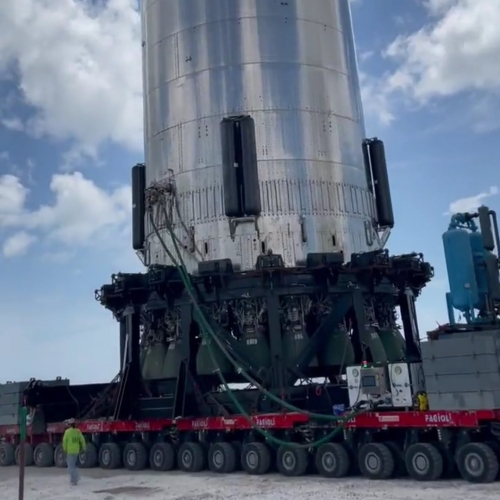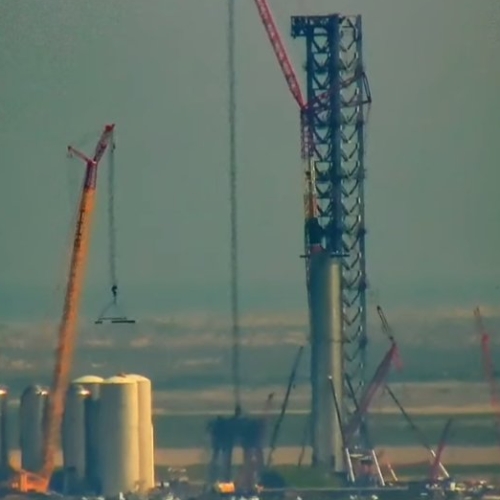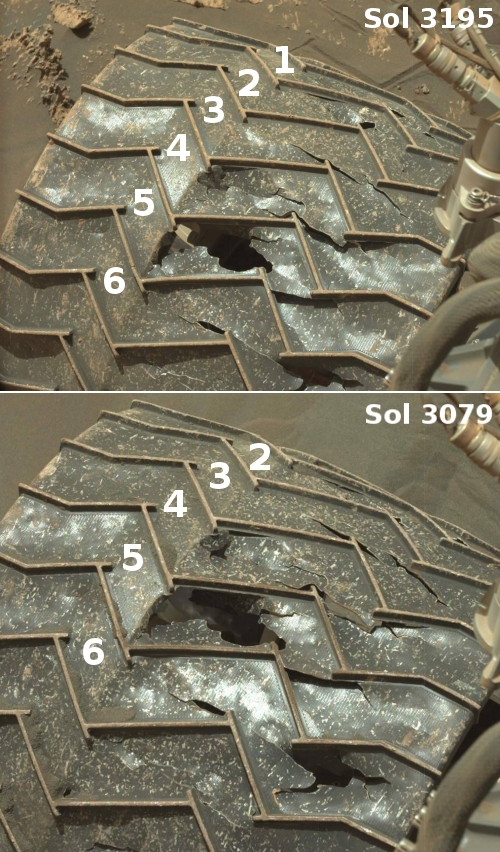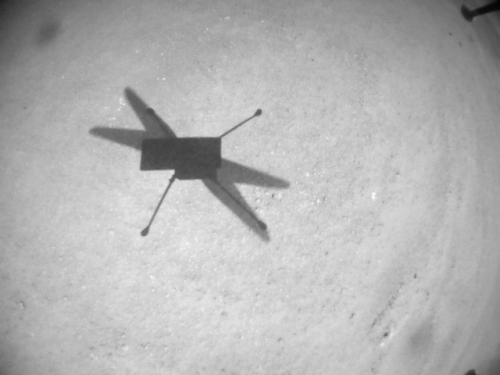Category: Behind The Black
Ingenuity successfully completes 11th flight
Ingenuity has successfully completed its 11th flight, safely touching down at approximately its planned landing spot. From the science team’s tweet:
[Ingenuity] has safely flown to a new location! Ingenuity flew for 130.9 seconds and traveled about 380 meters before landing.
The image to the right, reduced to post here, was taken mere seconds before landing, and shows the helicopter’s shadow directly below it on the ground.
This particular flight was the first that did not push Ingenuity’s abilities, merely flying in a straight line to put it in a good position for later flights and to keep it ahead of Perseverance.
So far they have only released five images from the flight. Expect the rest to be downloaded from Perseverance in the next few days.
Ingenuity has successfully completed its 11th flight, safely touching down at approximately its planned landing spot. From the science team’s tweet:
[Ingenuity] has safely flown to a new location! Ingenuity flew for 130.9 seconds and traveled about 380 meters before landing.
The image to the right, reduced to post here, was taken mere seconds before landing, and shows the helicopter’s shadow directly below it on the ground.
This particular flight was the first that did not push Ingenuity’s abilities, merely flying in a straight line to put it in a good position for later flights and to keep it ahead of Perseverance.
So far they have only released five images from the flight. Expect the rest to be downloaded from Perseverance in the next few days.
As thousands of teachers endorse critical race theory, home schooling surges

What apparently Critical Race Theory sees as education for
elementary school kids.
In the past few months state legislatures across the country have passed resolutions that ban schools from teaching the Marxist and bigoted program dubbed Critical Race Theory (CRT).
Not surprisingly, the leftists who dominate our school systems have fought back. The very leftist Zinn Education Project immediately created a petition calling for teachers to defy such laws and to continue to teach CRT, which teaches children to hate whites and to give minorities privileged status.
In the two months this petition has been on line almost 6,000 teachers have signed it, with many adding comments of defiance. This one is typical:
» Read more
Curiosity: Nine years since landing on Mars and the way forward
In today’s Curiosity update written by planetary geologist Abigail Fraeman, she noted this significant fact:
Project scientist Ashwin Vasavada pointed out a great fact at the beginning of planning today: At around 4 o’clock in the afternoon on Sol 3199 (the first sol in the plan we are creating today), Curiosity will begin its 10th Earth year on Mars. In the last nine years, the rover has traveled 26.3 km [16.3 miles], climbed over 460 m [1,509 feet] in elevation, and collected 32 drilled samples of rock.
Her update includes the first image taken by Curiosity upon landing, a view of Mount Sharp using the rover’s front hazard camera. In that picture, the mountain is far away, as the rover was sitting on the flat floor of Gale Crater.
The photo above, cropped and enhanced to post here, was taken yesterday by one of Curiosity’s navigation cameras, and looks out across the rocky mountainous terrain the rover is soon to travel. As Fraeman also notes,
» Read more
In today’s Curiosity update written by planetary geologist Abigail Fraeman, she noted this significant fact:
Project scientist Ashwin Vasavada pointed out a great fact at the beginning of planning today: At around 4 o’clock in the afternoon on Sol 3199 (the first sol in the plan we are creating today), Curiosity will begin its 10th Earth year on Mars. In the last nine years, the rover has traveled 26.3 km [16.3 miles], climbed over 460 m [1,509 feet] in elevation, and collected 32 drilled samples of rock.
Her update includes the first image taken by Curiosity upon landing, a view of Mount Sharp using the rover’s front hazard camera. In that picture, the mountain is far away, as the rover was sitting on the flat floor of Gale Crater.
The photo above, cropped and enhanced to post here, was taken yesterday by one of Curiosity’s navigation cameras, and looks out across the rocky mountainous terrain the rover is soon to travel. As Fraeman also notes,
» Read more
China’s Long March 6 launches two military technology test satellites
Using its Long March 6 rocket, China yesterday successfully placed two military technology test satellites into orbit, designed to test “new interference suppression technology for Ka-band mobile communications satellites.”
The launch occurred at one of China’s interior spaceports. No word on whether the rocket’s first stage crashed near habitable area.
The leaders in the 2021 launch race:
25 China
20 SpaceX
12 Russia
3 Northrop Grumman
3 Rocket Lab
The U.S. still leads China 30 to 25 in the national rankings.
Using its Long March 6 rocket, China yesterday successfully placed two military technology test satellites into orbit, designed to test “new interference suppression technology for Ka-band mobile communications satellites.”
The launch occurred at one of China’s interior spaceports. No word on whether the rocket’s first stage crashed near habitable area.
The leaders in the 2021 launch race:
25 China
20 SpaceX
12 Russia
3 Northrop Grumman
3 Rocket Lab
The U.S. still leads China 30 to 25 in the national rankings.
Details on the Russian movie to be shot on ISS in October
Link here. The article provides a lot of details about who will fly, who will do what, and who is slated as back-ups if the primary crew of actress and director fail their training. However, I found the description of the movie to be the most interesting thing:
Shipenko revealed the script is still being fine-tuned, but the plot involves a cosmonaut who suffers a cardiac arrest during a spacewalk and, although he survives, he will require surgery to ensure he can handle the Soyuz return to Earth. A female cardiac surgeon, named Zhenya, has to be sent to the ISS to perform the procedure with only a few weeks to prepare for the trip.
Unlike the American space films like Gravity, this story is incredibly well grounded in reality. The Russians have actually experienced examples of station astronauts getting so sick in space that their missions had to be aborted early. In one case it was a prostate infection. In another it was the mental illness of the entire crew.
This story is also comparable to situations that have occurred in Antarctica, a very similar environment to the station. In the early 2000s the doctor in Antarctica had to perform surgery on herself because she had developed cancer. Then in 2016 Buzz Aldrin had to be evacuated due health issues.
If done right, this could not only make a damn good movie, it will also do so by revealing the true dangers of going to space.
Link here. The article provides a lot of details about who will fly, who will do what, and who is slated as back-ups if the primary crew of actress and director fail their training. However, I found the description of the movie to be the most interesting thing:
Shipenko revealed the script is still being fine-tuned, but the plot involves a cosmonaut who suffers a cardiac arrest during a spacewalk and, although he survives, he will require surgery to ensure he can handle the Soyuz return to Earth. A female cardiac surgeon, named Zhenya, has to be sent to the ISS to perform the procedure with only a few weeks to prepare for the trip.
Unlike the American space films like Gravity, this story is incredibly well grounded in reality. The Russians have actually experienced examples of station astronauts getting so sick in space that their missions had to be aborted early. In one case it was a prostate infection. In another it was the mental illness of the entire crew.
This story is also comparable to situations that have occurred in Antarctica, a very similar environment to the station. In the early 2000s the doctor in Antarctica had to perform surgery on herself because she had developed cancer. Then in 2016 Buzz Aldrin had to be evacuated due health issues.
If done right, this could not only make a damn good movie, it will also do so by revealing the true dangers of going to space.
August 4, 2021 Zimmerman/Batchelor podcast
Embedded below the fold in two parts.
» Read more
Embedded below the fold in two parts.
» Read more
Seven Brides for Seven Brothers – Lonesome Polecat
An evening pause: This song, from the 1954 MGM classic musical, was one of the first evening pauses I posted back in 2010. As Diane and I recently rewatched the musical, I think it time to repost it. As I said then,
This haunting song from the movie Seven Brides for Seven Brothers is notable not only because of the beauty of the music and dancing, but because the entire number is shot as one take, no cuts. Everyone, from the actors with their axes to the crew moving the camera on its dolly and crane, had to be right on cue for everything to work.
Having spent almost twenty years in the movie business, I can promise you that this is not easy.
The 2010 evening pause uses the original voice of red-haired Matt Mattox, which was dubbed for the movie.
An evening pause: This song, from the 1954 MGM classic musical, was one of the first evening pauses I posted back in 2010. As Diane and I recently rewatched the musical, I think it time to repost it. As I said then,
This haunting song from the movie Seven Brides for Seven Brothers is notable not only because of the beauty of the music and dancing, but because the entire number is shot as one take, no cuts. Everyone, from the actors with their axes to the crew moving the camera on its dolly and crane, had to be right on cue for everything to work.
Having spent almost twenty years in the movie business, I can promise you that this is not easy.
The 2010 evening pause uses the original voice of red-haired Matt Mattox, which was dubbed for the movie.
White blobs on Mars
Time for another “What the heck?” image. The photo to the right, cropped to post here, was taken on May 18, 2021 by the high resolution camera on Mars Reconnaissance Orbiter (MRO). It shows what appears to be a series of white circular features aligned with a ridge line.
Are these eroded craters? Maybe, but their alignment with those ridges suggests otherwise. If you look at the full image, you will see further parallel ridges to the north and south, also with similar circular blobs lined along them. Furthermore, the flat surrounding terrain, part of the northern lowland plains north of the resurgences from Valles Marineris, has a scattering of very normal looking craters, with distinct rims and even some glacial material within. As this is at 44 degrees north latitude, the presence of glacial material inside craters is not surprising.
Thus, the white blobs are likely not craters, but some form of eruptive material from below, coming up along those ridges which are probably faultlines. The whiteness suggests that material is water ice, but this of course is unconfirmed.
The question is of course, why? What would cause water ice to erupt along these faultlines? And why are such features not seen elsewhere? Faults and underground ice are common on Mars. Yet, I don’t remember seeing features such as this in any other Martian images.
Time for another “What the heck?” image. The photo to the right, cropped to post here, was taken on May 18, 2021 by the high resolution camera on Mars Reconnaissance Orbiter (MRO). It shows what appears to be a series of white circular features aligned with a ridge line.
Are these eroded craters? Maybe, but their alignment with those ridges suggests otherwise. If you look at the full image, you will see further parallel ridges to the north and south, also with similar circular blobs lined along them. Furthermore, the flat surrounding terrain, part of the northern lowland plains north of the resurgences from Valles Marineris, has a scattering of very normal looking craters, with distinct rims and even some glacial material within. As this is at 44 degrees north latitude, the presence of glacial material inside craters is not surprising.
Thus, the white blobs are likely not craters, but some form of eruptive material from below, coming up along those ridges which are probably faultlines. The whiteness suggests that material is water ice, but this of course is unconfirmed.
The question is of course, why? What would cause water ice to erupt along these faultlines? And why are such features not seen elsewhere? Faults and underground ice are common on Mars. Yet, I don’t remember seeing features such as this in any other Martian images.
Today’s blacklisted American: Cybersecurity experts want people fired for expressing unpopular opinions on line

Mao’s cultural revolution in 1966, what the leftists
at Respect in Security want for America and the world.
Persecution is now cool! A new project being developed by leftist cybersecurity experts calls for corporations to use their software to identify and fire individuals that their software identifies as having expressed what they define as “offensive” speech online.
Cancel Culture and Big Tech are a match made in hell, as cybersecurity experts call to target the livelihood of internet users who get too edgy online. “The initiative, called Respect in Security, was launched on Tuesday by two cybersecurity experts. According to the founders, several companies have already signed up,” Reclaim The Net reported. “For a lot of people, it’s a no man’s land,” founder Lisa Forte and Red Goat Cyber Security employee told the BBC. “It can feel like the platforms do nothing, the police don’t do a lot, lawyers are expensive and the publicity legal action generates can be negative.”
The BBC reported that co-founder and Trend Micro Vice President Rik Ferguson said “many companies had anti-bullying policies but they tended to focus on internal behaviour.” In what may be a reference to his Respect in Security program, he wrote a few weeks ago: “Inside my ‘Projects’ email folder resides a subfolder called ‘Kill Trolls’ and it is now only a couple of weeks away from becoming a real thing (sadly not with that name).”
Free speech advocates concerned about Ferguson and Forte’s work may have good reason to be. Forte explained her clear fix for people saying offensive statements via the internet: “The best solution we have, if the culprit is identifiable, is to approach their employer.” [emphasis mine]
It is bad enough that the big social media companies — Google, Facebook, Twitter — are routinely banning conservatives for expressing opinions or even facts they don’t like. Now the storm troopers above want to extend the blacklisting to get those same people fired for daring to speak their mind publicly. From another story:
» Read more

Mao’s cultural revolution in 1966, what the leftists
at Respect in Security want for America and the world.
Persecution is now cool! A new project being developed by leftist cybersecurity experts calls for corporations to use their software to identify and fire individuals that their software identifies as having expressed what they define as “offensive” speech online.
Cancel Culture and Big Tech are a match made in hell, as cybersecurity experts call to target the livelihood of internet users who get too edgy online. “The initiative, called Respect in Security, was launched on Tuesday by two cybersecurity experts. According to the founders, several companies have already signed up,” Reclaim The Net reported. “For a lot of people, it’s a no man’s land,” founder Lisa Forte and Red Goat Cyber Security employee told the BBC. “It can feel like the platforms do nothing, the police don’t do a lot, lawyers are expensive and the publicity legal action generates can be negative.”
The BBC reported that co-founder and Trend Micro Vice President Rik Ferguson said “many companies had anti-bullying policies but they tended to focus on internal behaviour.” In what may be a reference to his Respect in Security program, he wrote a few weeks ago: “Inside my ‘Projects’ email folder resides a subfolder called ‘Kill Trolls’ and it is now only a couple of weeks away from becoming a real thing (sadly not with that name).”
Free speech advocates concerned about Ferguson and Forte’s work may have good reason to be. Forte explained her clear fix for people saying offensive statements via the internet: “The best solution we have, if the culprit is identifiable, is to approach their employer.” [emphasis mine]
It is bad enough that the big social media companies — Google, Facebook, Twitter — are routinely banning conservatives for expressing opinions or even facts they don’t like. Now the storm troopers above want to extend the blacklisting to get those same people fired for daring to speak their mind publicly. From another story:
» Read more
Ingenuity’s 11th flight scheduled for tonight
The next flight of Ingenuity on Mars is now scheduled for this evening, and will be a much simpler flight than the helicopter’s previous trip.
The map to the right shows the route in blue. The flight is mainly a transfer flight, intended to keep the copter ahead of the rover as they leapfrog from point to point in Jezero Crater. It will actually be the first flight by Ingenuity that does not push its engineering in any major way.
This map, the most up-to-date available, is at this moment about five sols out of date. Perseverance is likely slightly south and to the west of the location shown.
The present plan is for Perseverance to travel to the northwest along the dark ridgeline that Ingenuity will land next to. The rover will then retreat, returning more or less to its landing area and then north to circle around the largest crater on the map and then to head west to the base of the delta to the area labeled “Three Forks”, which is their entrance to the delta’s geology.
The next flight of Ingenuity on Mars is now scheduled for this evening, and will be a much simpler flight than the helicopter’s previous trip.
The map to the right shows the route in blue. The flight is mainly a transfer flight, intended to keep the copter ahead of the rover as they leapfrog from point to point in Jezero Crater. It will actually be the first flight by Ingenuity that does not push its engineering in any major way.
This map, the most up-to-date available, is at this moment about five sols out of date. Perseverance is likely slightly south and to the west of the location shown.
The present plan is for Perseverance to travel to the northwest along the dark ridgeline that Ingenuity will land next to. The rover will then retreat, returning more or less to its landing area and then north to circle around the largest crater on the map and then to head west to the base of the delta to the area labeled “Three Forks”, which is their entrance to the delta’s geology.
Gil Levin passes away
Gil Levin, a instrument project scientist for one of the science experiments on the Mars Viking landers in the 1970s, has passed away at 97.
Levin deserves special mention because he believed for years that his experiment, called “labeled release,” had possibly found evidence of life.
Dr. Levin’s experiment employed a nine-foot arm to scoop Martian soil into a container, where it was treated with a solution containing radioactive carbon nutrients. Monitors detected the release of radioactive gas, which Dr. Levin interpreted as evidence of metabolism.
“Gil, that’s life,” Straat said when they saw the results.
The findings held true for both Viking 1 and Viking 2, which took samples from different regions of the planet. Other experiments aboard the Viking, however, used different methods to conclude that Martian soil did not contain carbon, an element found in all living things.
Dr. Levin stood by his findings, but top NASA scientists disagreed, saying that the response he observed was the result of inorganic chemical responses, not biological processes. “Soon thereafter,” Dr. Levin told the Johns Hopkins University School of Engineering Magazine last year, “I gave a talk at the National Academy of Sciences saying we detected life, and there was an uproar. Attendees shouted invectives at me. They were ready to throw shrimp at me from the shrimp bowl. One former adviser said, ‘You’ve disgraced yourself, and you’ve disgraced science.’”
I met Levin once and interviewed him several times. With amazing grace and cheerfulness he always emphasized that his results needed to be confirmed, and there was certainly room for skepticism, but to reject them outright was not how the scientific method worked.
Levin however was never awarded another NASA project, essentially blackballed because of his 1970s claims, even though later research hinted at the possibility that he may have been right.
R.I.P. Gil Levin. Though the overall data we have gotten from Mars in the half century since still favors a non-life explanation for his experiment, the uncertainty remains quite large. He could have been right.
More important than his uncertain result, however, was his dedication to the proper scientific method, where you let the data speak for itself and never dismiss any possibility if that is what the data shows you.
Gil Levin, a instrument project scientist for one of the science experiments on the Mars Viking landers in the 1970s, has passed away at 97.
Levin deserves special mention because he believed for years that his experiment, called “labeled release,” had possibly found evidence of life.
Dr. Levin’s experiment employed a nine-foot arm to scoop Martian soil into a container, where it was treated with a solution containing radioactive carbon nutrients. Monitors detected the release of radioactive gas, which Dr. Levin interpreted as evidence of metabolism.
“Gil, that’s life,” Straat said when they saw the results.
The findings held true for both Viking 1 and Viking 2, which took samples from different regions of the planet. Other experiments aboard the Viking, however, used different methods to conclude that Martian soil did not contain carbon, an element found in all living things.
Dr. Levin stood by his findings, but top NASA scientists disagreed, saying that the response he observed was the result of inorganic chemical responses, not biological processes. “Soon thereafter,” Dr. Levin told the Johns Hopkins University School of Engineering Magazine last year, “I gave a talk at the National Academy of Sciences saying we detected life, and there was an uproar. Attendees shouted invectives at me. They were ready to throw shrimp at me from the shrimp bowl. One former adviser said, ‘You’ve disgraced yourself, and you’ve disgraced science.’”
I met Levin once and interviewed him several times. With amazing grace and cheerfulness he always emphasized that his results needed to be confirmed, and there was certainly room for skepticism, but to reject them outright was not how the scientific method worked.
Levin however was never awarded another NASA project, essentially blackballed because of his 1970s claims, even though later research hinted at the possibility that he may have been right.
R.I.P. Gil Levin. Though the overall data we have gotten from Mars in the half century since still favors a non-life explanation for his experiment, the uncertainty remains quite large. He could have been right.
More important than his uncertain result, however, was his dedication to the proper scientific method, where you let the data speak for itself and never dismiss any possibility if that is what the data shows you.
Lemon Pipers – Green Tambourine
An evening pause: From yesterday’s cutting edge graphics we go to the early days of television color special effects, taped in 1968. Hardly as convincing, but with a sense of light-hearted fun that is quite infectious.
I also wonder how much drugs were involved with the writing, recording, playing and televising of this song.
Hat tip Tom Biggar.
I am still in need for evening pause suggestions. If you’ve suggested before you know the routine. If you haven’t and want submit something, say so in a comment and I will forward you the guidelines. Don’t reveal your suggestion in the comment, or I won’t be able to use it.
Superheavy prototype #4 rolls to orbital launchpad


Click for live stream.
Capitalism in space: SpaceX today rolled its 4th Superheavy prototype from its assembly building in Boca Chica, Texas, moving it to the orbital launchpad in preparation for having the 20th Starship prototype stacked on top and assembled for the rocket’s first orbital test flight.
The first image to the right is a screen capture taken from a short movie posted in an Elon Musk tweet. It shows the base of this Superheavy, with its 29 Raptor engines. The engines appear surrounded by the support structure that holds the stage to the truck mover.
The second image to the right is a screen capture from Labpadre’s live stream Saphire camera, captured shortly before this post was published. Superheavy is 230 feet tall. Starship is 165 feet tall. Combined that equals just under 400 feet, which is still about 30 feet taller than the Saturn-5.
Yet, Superheavy is easily dwarfed by the launch tower behind it, and when they stack Starship on top the combined rocket will still be only three quarters as tall as the tower. They are using that tower not only for launches, but for stacking of Starship as well as a capture devise for when later Superheavies return to Earth. Instead of having landing legs, Superheavy will eventually lower itself into position next to the tower and hover there so that the tower can grab it.
All this means the tower needs to be taller than the combined rocket. I would also expect that a second tower will be necessary eventually for that landing grab.
Before they stack Starship #20 on top they will likely do pressure and tank tests of Superheavy, and maybe a few dress rehearsal countdowns leading to short static fire tests.
It still appears to me that we are looking for an orbital test flight sometime in late September, early October.


Click for live stream.
Capitalism in space: SpaceX today rolled its 4th Superheavy prototype from its assembly building in Boca Chica, Texas, moving it to the orbital launchpad in preparation for having the 20th Starship prototype stacked on top and assembled for the rocket’s first orbital test flight.
The first image to the right is a screen capture taken from a short movie posted in an Elon Musk tweet. It shows the base of this Superheavy, with its 29 Raptor engines. The engines appear surrounded by the support structure that holds the stage to the truck mover.
The second image to the right is a screen capture from Labpadre’s live stream Saphire camera, captured shortly before this post was published. Superheavy is 230 feet tall. Starship is 165 feet tall. Combined that equals just under 400 feet, which is still about 30 feet taller than the Saturn-5.
Yet, Superheavy is easily dwarfed by the launch tower behind it, and when they stack Starship on top the combined rocket will still be only three quarters as tall as the tower. They are using that tower not only for launches, but for stacking of Starship as well as a capture devise for when later Superheavies return to Earth. Instead of having landing legs, Superheavy will eventually lower itself into position next to the tower and hover there so that the tower can grab it.
All this means the tower needs to be taller than the combined rocket. I would also expect that a second tower will be necessary eventually for that landing grab.
Before they stack Starship #20 on top they will likely do pressure and tank tests of Superheavy, and maybe a few dress rehearsal countdowns leading to short static fire tests.
It still appears to me that we are looking for an orbital test flight sometime in late September, early October.
Chinese pseudo-private rocket fails during launch
A launch attempt by the pseudo-private Chinese company iSpace failed today, the second failure in a row for this company following a success.
A Hyperbola 1 rocket lifted off from the Jiuquan launch base at 3:39 a.m. EDT (0739 GMT; 3:39 p.m. Beijing time), China’s government-run Xinhua news agency said. Xinhua, which described the launch as a “flight test,” said the rocket exhibited “abnormal performance” after liftoff. Officials did not immediately specify when during the flight the rocket failed.
The news agency said a satellite carried by the rocket “did not enter orbit as scheduled.” Chinese officials did not identify the payload lost on the mission.
This is the second launch failure in a row, following the first successful orbital launch in July 2019.
The rocket is made of four solid-fueled stages, which means it most certainly is using military tecnology and is being closely supervised by the Chinese government. ISpace is one of about four such pseudo-private Chines companies. In each case, China is allowing private Chinese capital to finance the development of these rockets, for use both by the Chinese government as well as sale to customers (but only with the government’s approval and control).
A launch attempt by the pseudo-private Chinese company iSpace failed today, the second failure in a row for this company following a success.
A Hyperbola 1 rocket lifted off from the Jiuquan launch base at 3:39 a.m. EDT (0739 GMT; 3:39 p.m. Beijing time), China’s government-run Xinhua news agency said. Xinhua, which described the launch as a “flight test,” said the rocket exhibited “abnormal performance” after liftoff. Officials did not immediately specify when during the flight the rocket failed.
The news agency said a satellite carried by the rocket “did not enter orbit as scheduled.” Chinese officials did not identify the payload lost on the mission.
This is the second launch failure in a row, following the first successful orbital launch in July 2019.
The rocket is made of four solid-fueled stages, which means it most certainly is using military tecnology and is being closely supervised by the Chinese government. ISpace is one of about four such pseudo-private Chines companies. In each case, China is allowing private Chinese capital to finance the development of these rockets, for use both by the Chinese government as well as sale to customers (but only with the government’s approval and control).
Today’s blacklisted American: 65,000 Americans censored by social media

The Bill of Rights cancelled by
Google, Facebook, and Twitter.
The new dark age of silencing According to the legal team for former president Donald Trump, almost 65,000 people have submitted examples of censorship by the social media companies Google, Facebook, and Twitter, and the lawyers have amended Trump’s the lawsuit to add those individuals to it.
According to the America First Policy Institute (AFPI), Trump’s July 7 lawsuit against Facebook, Twitter, and Google is adding ”additional censorship experiences” from some of the nearly 65,000 people who submitted them to the institute. ”Late last night, Amended Complaints were filed in the Big Tech lawsuits against Facebook, Inc., Mark Zuckerberg, Twitter, Inc., Jack Dorsey, Google LLC, and Sundar Pichai,” AFPI said in a July 28 statement.
“Since the initial filing on July 7, 2021, nearly 65,000 American people have submitted their stories of censorship through America First Policy Institute’s (AFPI) Constitutional Litigation Partnership (CLP) at TakeOnBigTech.com,” AFPI added.

The Bill of Rights cancelled by
Google, Facebook, and Twitter.
The new dark age of silencing According to the legal team for former president Donald Trump, almost 65,000 people have submitted examples of censorship by the social media companies Google, Facebook, and Twitter, and the lawyers have amended Trump’s the lawsuit to add those individuals to it.
According to the America First Policy Institute (AFPI), Trump’s July 7 lawsuit against Facebook, Twitter, and Google is adding ”additional censorship experiences” from some of the nearly 65,000 people who submitted them to the institute. ”Late last night, Amended Complaints were filed in the Big Tech lawsuits against Facebook, Inc., Mark Zuckerberg, Twitter, Inc., Jack Dorsey, Google LLC, and Sundar Pichai,” AFPI said in a July 28 statement.
“Since the initial filing on July 7, 2021, nearly 65,000 American people have submitted their stories of censorship through America First Policy Institute’s (AFPI) Constitutional Litigation Partnership (CLP) at TakeOnBigTech.com,” AFPI added.
Curiosity’s wheels: a good news update

Click here and here for the original images.
For the past few weeks Curiosity has been traveling across some of the roughest terrain it has seen on Mars, since landing in Gale Crater in August 2012. The rover is now roving among the high cliffs and foothills at the very base of Mt Sharp, with the ground covered with rocks, boulders, plates of bedrock, and all sorts of protrusions.
On August 1st the rover team used its cameras to do another survey of the rover’s wheels to see how they fared during that journey. The two images to the right compare the same area on the same wheel after the most recent 16 sols of travel. This is the same wheel I have focused on since 2017. Overall, the damage in the most recent picture seems almost identical to the previous picture. In fact, if you compare today’s image with the annotated version of the 2017 photo, found here, you can see how little things have changed since then.
From this one wheel it appears that the wheels are continuing to hold up quite well. The Curiosity team of course needs to review all the images of all the wheels, but based on this one comparison, it looks like their long term strategies for mitigating damage to the wheels is working, even in the rough terrain the rover is presently traversing.

Click here and here for the original images.
For the past few weeks Curiosity has been traveling across some of the roughest terrain it has seen on Mars, since landing in Gale Crater in August 2012. The rover is now roving among the high cliffs and foothills at the very base of Mt Sharp, with the ground covered with rocks, boulders, plates of bedrock, and all sorts of protrusions.
On August 1st the rover team used its cameras to do another survey of the rover’s wheels to see how they fared during that journey. The two images to the right compare the same area on the same wheel after the most recent 16 sols of travel. This is the same wheel I have focused on since 2017. Overall, the damage in the most recent picture seems almost identical to the previous picture. In fact, if you compare today’s image with the annotated version of the 2017 photo, found here, you can see how little things have changed since then.
From this one wheel it appears that the wheels are continuing to hold up quite well. The Curiosity team of course needs to review all the images of all the wheels, but based on this one comparison, it looks like their long term strategies for mitigating damage to the wheels is working, even in the rough terrain the rover is presently traversing.
The annual July fund-raising campaign: Thank you!
This post will remain at the top of the page for the next few days. Scroll down for news updates and commentaries.
My July fund-raising campaign for 2021 has now ended. Thank you all for your donations and subscriptions. While this year’s campaign was not as spectacular as last year’s, it was the second best July campaign since I began this website. My gratitude cannot be expressed adequately.
As already mentioned, a handful of people have donated enough for a free ebook, but have not responded to my requests for which book they wish and in what format. I can’t give you this gift if you don’t tell me what you want. Will those individuals please email me the book and the format (epup or pdf) they desire?
I once again must express my gratitude to everyone for their support. No one is obliged to pay anything to read my website. That so many people are willing to give freely warms my heart, and gives me hope that I am not the only person left who believes in fearless exploration and freedom.
Martian lava flooded crater?
A quick cool image! The photo to the right, rotated, cropped and reduced to post here, was taken by the high resolution camera on Mars Reconnaissance Orbiter (MRO) more than a decade ago, on June 1, 2010. I post it now because it is today’s MRO picture of the day, and is definitely cool. The caption:
One of a few “scaly-looking” inselbergs within regional platy-ridged flows in Elysium Planitia. This inselberg has a broken and blocky appearance with some of the blocks being tilted. Could this be the remnant of a once extensive mantling deposit? An inselberg is an isolated hill or mountain rising abruptly from a plain.
The wider image by MRO’s context camera below, also rotated, cropped and reduced to post here, illustrates even more forcefully how isolated this circular set of blocks is.
» Read more
A quick cool image! The photo to the right, rotated, cropped and reduced to post here, was taken by the high resolution camera on Mars Reconnaissance Orbiter (MRO) more than a decade ago, on June 1, 2010. I post it now because it is today’s MRO picture of the day, and is definitely cool. The caption:
One of a few “scaly-looking” inselbergs within regional platy-ridged flows in Elysium Planitia. This inselberg has a broken and blocky appearance with some of the blocks being tilted. Could this be the remnant of a once extensive mantling deposit? An inselberg is an isolated hill or mountain rising abruptly from a plain.
The wider image by MRO’s context camera below, also rotated, cropped and reduced to post here, illustrates even more forcefully how isolated this circular set of blocks is.
» Read more
Two flybys of Venus set by two spacecraft on August 9th and 10th
Two European planetary probes, one launched to study the inner solar enviroment and the second to study Mercury, are going to fly past Venus only 33 hours apart on August 9th and 10th.
Solar Orbiter, a partnership between ESA and NASA, will fly by Venus on 9 August with a closest approach of 7995 km at 04:42 UTC. Throughout its mission it makes repeated gravity assist flybys of Venus to get closer to the Sun, and to change its orbital inclination, boosting it out of the ecliptic plane, to get the best – and first – views of the Sun’s poles.
BepiColombo, a partnership between ESA and JAXA, will fly by Venus at 13:48 UTC on 10 August at an altitude of just 550 km. BepiColombo is on its way to the mysterious innermost planet of the solar system, Mercury. It needs flybys of Earth, Venus and Mercury itself, together with the spacecraft’s solar electric propulsion system, to help steer into Mercury orbit against the immense gravitational pull of the Sun.
The two spacecraft will zip past a different side of Venus. For a variety of reasons, the imagery gathered will not of high resolution, though both spacecraft will gather data that will eventually be correlated with similar data being gathered by Japan’s Akatsuki probe, in orbit around Venus since 2015.
Two European planetary probes, one launched to study the inner solar enviroment and the second to study Mercury, are going to fly past Venus only 33 hours apart on August 9th and 10th.
Solar Orbiter, a partnership between ESA and NASA, will fly by Venus on 9 August with a closest approach of 7995 km at 04:42 UTC. Throughout its mission it makes repeated gravity assist flybys of Venus to get closer to the Sun, and to change its orbital inclination, boosting it out of the ecliptic plane, to get the best – and first – views of the Sun’s poles.
BepiColombo, a partnership between ESA and JAXA, will fly by Venus at 13:48 UTC on 10 August at an altitude of just 550 km. BepiColombo is on its way to the mysterious innermost planet of the solar system, Mercury. It needs flybys of Earth, Venus and Mercury itself, together with the spacecraft’s solar electric propulsion system, to help steer into Mercury orbit against the immense gravitational pull of the Sun.
The two spacecraft will zip past a different side of Venus. For a variety of reasons, the imagery gathered will not of high resolution, though both spacecraft will gather data that will eventually be correlated with similar data being gathered by Japan’s Akatsuki probe, in orbit around Venus since 2015.
SpaceX installs 29 Raptor engines on Superheavy #4
Capitalism in space: SpaceX has now installed 29 Raptor engines on the fourth Superheavy prototype, intended to be the first to attempt an orbital launch, even as the company also prepares Starship prototype #20 for that flight.
In a marked increase to the already-impressive production cadence at SpaceX Starbase, it’s all hands on deck with Booster 4 and Ship 20 preparations ahead of the duo being sent to the launch site. Booster 4 was stacked on Sunday, with all 29 Raptors installed by Monday morning. While the orbital launch attempt is not imminent, the duo is expected to undergo a series of ground testing objectives, including multiple Static Fire tests for the booster. This will also provide time to complete the final elements of the Orbital Launch Site (OLS), from which the duo will conduct the milestone test flight.
Following a short ground testing campaign with Booster 3, which included cryo proofing and a three-engine Static Fire test, the focus is now on what will become the first integrated stack of a Super Heavy booster and a Starship vehicle. This is set to be achieved in double-quick time, following a call to arms from SpaceX to its workforce. This included the transportation of hundreds of workers from other sites in the country, as per a memo leaked on Facebook.
As predicted, SpaceX did not succeed in launching Superheavy/Starship on its first orbital test flight in August. However, as predicted the company is clearly pushing to attempt that flight before the end of the summer. Right now, based on the pace of operations, what has been accomplished, and what needs to be accomplished, I estimate that flight will likely occur sometime around late September to early October.
It also seems very obvious that SpaceX is trying very hard to beat SLS into orbit. If successful, it will underline most starkly the difference between free enterprise and government operations. The former got it done in about four years, for less than $6 billion. The latter has taken seventeen years, and about $60 billion, and has still not launched.
And even if SLS launches first, that contrast remains.
Capitalism in space: SpaceX has now installed 29 Raptor engines on the fourth Superheavy prototype, intended to be the first to attempt an orbital launch, even as the company also prepares Starship prototype #20 for that flight.
In a marked increase to the already-impressive production cadence at SpaceX Starbase, it’s all hands on deck with Booster 4 and Ship 20 preparations ahead of the duo being sent to the launch site. Booster 4 was stacked on Sunday, with all 29 Raptors installed by Monday morning. While the orbital launch attempt is not imminent, the duo is expected to undergo a series of ground testing objectives, including multiple Static Fire tests for the booster. This will also provide time to complete the final elements of the Orbital Launch Site (OLS), from which the duo will conduct the milestone test flight.
Following a short ground testing campaign with Booster 3, which included cryo proofing and a three-engine Static Fire test, the focus is now on what will become the first integrated stack of a Super Heavy booster and a Starship vehicle. This is set to be achieved in double-quick time, following a call to arms from SpaceX to its workforce. This included the transportation of hundreds of workers from other sites in the country, as per a memo leaked on Facebook.
As predicted, SpaceX did not succeed in launching Superheavy/Starship on its first orbital test flight in August. However, as predicted the company is clearly pushing to attempt that flight before the end of the summer. Right now, based on the pace of operations, what has been accomplished, and what needs to be accomplished, I estimate that flight will likely occur sometime around late September to early October.
It also seems very obvious that SpaceX is trying very hard to beat SLS into orbit. If successful, it will underline most starkly the difference between free enterprise and government operations. The former got it done in about four years, for less than $6 billion. The latter has taken seventeen years, and about $60 billion, and has still not launched.
And even if SLS launches first, that contrast remains.
Starliner launch scrubbed; no launch date yet set
For reasons that have not yet been revealed, ULA scrubbed today’s unmanned demo test flight of Boeing’s Starliner capsule just prior to launch, rescheduling the launch for tomorrow.
The launch tomorrow wiill occur at 12:57 am (Eastern).
UPDATE: It appears the scrub occurred because of a valve issue in the propulsion system of Boeing’s Starliner capsule.
“During pre-launch preparations for the uncrewed test flight of the CST-100 Starliner spacecraft, Boeing engineers monitoring the health and status of the vehicle detected unexpected valve position indications in the propulsion system,” the company said in a statement. “The issue was initially detected during check outs following yesterday’s electrical storms in the region of Kennedy Space Center.”
…The propulsion system valves in question are inside the Starliner’s service module, which has an array of rocket thrusters designed to propel the spacecraft away from its launcher during an in-flight emergency. Other thrusters on the service module are used for in-orbit maneuvers and spacecraft pointing control.
Boeing cannot afford more failures during this second demo flight. The company has been plagued with numerous debilitating technical failures during the past four years, from Starliner to its airlines. Right now the failure to get Starliner operational is losing them business in the emerging orbital tourist market. They need to get it working, and working reliably.
UPDATE: They have decided to cancel the launch plans for tomorrow, to roll the rocket back into the assembly building so they can do more tests on the capsule’s service module where the troublesome valves are.
For reasons that have not yet been revealed, ULA scrubbed today’s unmanned demo test flight of Boeing’s Starliner capsule just prior to launch, rescheduling the launch for tomorrow.
The launch tomorrow wiill occur at 12:57 am (Eastern).
UPDATE: It appears the scrub occurred because of a valve issue in the propulsion system of Boeing’s Starliner capsule.
“During pre-launch preparations for the uncrewed test flight of the CST-100 Starliner spacecraft, Boeing engineers monitoring the health and status of the vehicle detected unexpected valve position indications in the propulsion system,” the company said in a statement. “The issue was initially detected during check outs following yesterday’s electrical storms in the region of Kennedy Space Center.”
…The propulsion system valves in question are inside the Starliner’s service module, which has an array of rocket thrusters designed to propel the spacecraft away from its launcher during an in-flight emergency. Other thrusters on the service module are used for in-orbit maneuvers and spacecraft pointing control.
Boeing cannot afford more failures during this second demo flight. The company has been plagued with numerous debilitating technical failures during the past four years, from Starliner to its airlines. Right now the failure to get Starliner operational is losing them business in the emerging orbital tourist market. They need to get it working, and working reliably.
UPDATE: They have decided to cancel the launch plans for tomorrow, to roll the rocket back into the assembly building so they can do more tests on the capsule’s service module where the troublesome valves are.
Nauka shook up ISS more than first revealed
According to new reporting, when the new Russian module Nauka unexpectedly began firing its engines, it rotated the International Space Station far more than first revealed, requiring a much more complicated effort to bring the station back to its correct orientation.
Zebulon Scoville, the flight director at NASA mission control in Houston, revealed that the 45 degrees that was initially reported as the amount ISS rotated was incorrect.
According to Scoville, the event has “been a little incorrectly reported.” He said that after Nauka incorrectly fired up, the station “spun one-and-a-half revolutions — about 540 degrees — before coming to a stop upside down. The space station then did a 180-degree forward flip to get back to its original orientation,” according to the report.
Scoville also shared that this was the first time that he has ever declared a “spacecraft emergency.”
It appears that though the station spun far more than first reported, the rate of rotation was still relatively slow, so it apparently did no harm to the station.
Scoville also revealed that, based on the data on hand during the event, it appeared Nauka was also trying to undock itself from the station. Mission controllers tried to counter this by firing engines on a Russian Progress freighter as well as on the Zvezda module.
Had Nauka’s engines had not stopped firing (for unknown reasons, though probably because they ran out of fuel), there was the real chance the accelerations could have shaken the station apart. Moreover, that other engines were brought into play suggests that the Russians not only did not know why Nauka’s engines fired, they had at the time no way to shut them down, and were thus forced to improvise other actions to try to save the increasingly dangerous situation.
According to new reporting, when the new Russian module Nauka unexpectedly began firing its engines, it rotated the International Space Station far more than first revealed, requiring a much more complicated effort to bring the station back to its correct orientation.
Zebulon Scoville, the flight director at NASA mission control in Houston, revealed that the 45 degrees that was initially reported as the amount ISS rotated was incorrect.
According to Scoville, the event has “been a little incorrectly reported.” He said that after Nauka incorrectly fired up, the station “spun one-and-a-half revolutions — about 540 degrees — before coming to a stop upside down. The space station then did a 180-degree forward flip to get back to its original orientation,” according to the report.
Scoville also shared that this was the first time that he has ever declared a “spacecraft emergency.”
It appears that though the station spun far more than first reported, the rate of rotation was still relatively slow, so it apparently did no harm to the station.
Scoville also revealed that, based on the data on hand during the event, it appeared Nauka was also trying to undock itself from the station. Mission controllers tried to counter this by firing engines on a Russian Progress freighter as well as on the Zvezda module.
Had Nauka’s engines had not stopped firing (for unknown reasons, though probably because they ran out of fuel), there was the real chance the accelerations could have shaken the station apart. Moreover, that other engines were brought into play suggests that the Russians not only did not know why Nauka’s engines fired, they had at the time no way to shut them down, and were thus forced to improvise other actions to try to save the increasingly dangerous situation.
Blender FLIP Fluids Addon
An evening pause: What you are looking at here appears to be a demo video of a software addon that provides users with all types of liquid visuals. And creating realistic flowing water is not easy, as the splashes and waves represent chaotic behavior which is very hard to model.
Hat tip Cotour, who adds, “At some point in the future there will be ‘reality’ and no one will be able to tell the difference.”
The sublimating surface of Mars’ northern plains?
Cool image time! The photograph to the right, cropped and reduced to post here, was taken by the high resolution camera on Mars Reconnaissance Orbiter on May 27, 2021. A sample image, likely taken not as part of any specific scientist’s research but by the camera team in order to maintain the camera’s temperature, shows an area of the Martian northern plains that appears filled with rough scattered depressions, possibly caused by sublimation of buried ice.
The location, at 54 degrees north latitude, is far enough north to easily have a lot of buried ice. It is also only about 40 miles to the east of Milankovič Crater, where scientists have found many scarps that appear to have exposed layers of ice in their cliff faces.
However, the location has other components that must raise questions about this sublimating ice hypothesis.
» Read more
Cool image time! The photograph to the right, cropped and reduced to post here, was taken by the high resolution camera on Mars Reconnaissance Orbiter on May 27, 2021. A sample image, likely taken not as part of any specific scientist’s research but by the camera team in order to maintain the camera’s temperature, shows an area of the Martian northern plains that appears filled with rough scattered depressions, possibly caused by sublimation of buried ice.
The location, at 54 degrees north latitude, is far enough north to easily have a lot of buried ice. It is also only about 40 miles to the east of Milankovič Crater, where scientists have found many scarps that appear to have exposed layers of ice in their cliff faces.
However, the location has other components that must raise questions about this sublimating ice hypothesis.
» Read more
Today’s blacklisted American: Biracial physician demoted by hospital for criticizing the left

Beliefs apparently required of doctors at the Hennepin Healthcare system
The new dark age of silencing: Tara Gustilo, a biracial physician from the Philippines, found herself quickly demoted from her position as chairwoman of the OB-GYN department for the Hennepin Healthcare system in Minnesota when she dared to post on social media commentary against the Marxist and bigoted Black Lives Matter organization and the equally bigoted critical race theory being pushed by leftist educators in the public schools.
» Read more

Beliefs apparently required of doctors at the Hennepin Healthcare system
The new dark age of silencing: Tara Gustilo, a biracial physician from the Philippines, found herself quickly demoted from her position as chairwoman of the OB-GYN department for the Hennepin Healthcare system in Minnesota when she dared to post on social media commentary against the Marxist and bigoted Black Lives Matter organization and the equally bigoted critical race theory being pushed by leftist educators in the public schools.
» Read more
Upcoming Zimmerman public lecture available for all – Last Call!
Tomorrow I will be giving a lecture on the Artemis Accords to the Arizona Space Business Roundtable, a monthly event in Tucson, founded by space businessman and local all-around good guy Stephen Fleming, to bring together the business-oriented space community of this city and southern Arizona.
From Stephen Fleming’s announcement:
Bob has spoken to the Roundtable before; this time, I’ve asked him to focus on the Artemis Accords… the USA’s attempt to “to create a safe and transparent environment which facilitates exploration, science, and commercial activities for all of humanity to enjoy.” What does that mean? It’s an attempt to break the international logjam that has blocked the private sector development and exploitation of resources on the Moon, asteroids, and other celestial bodies. How is it working, who has joined on, and what does China think about all this? Come find out from Bob!
The event will be open to the public, no charge, and will also be available on Zoom. It is scheduled for Tuesday, August 3, 2021, from 5:00 — 6:30 pm (Arizona time, which presently corresponds to Pacific time).
If you wish to come in person, the event will be at 110 E. Pennington St, Room 215, in Tucson.
If you want to attend via Zoom, you will need to express your interest as a comment below, and I will then email you the Zoom url and password. We are not publishing this information publicly to avoid a hacking during the event.
Let me repeat: You need to express an interest in attending by Zoom by posting a comment. Otherwise you will not get the password and will not be able to watch. (I will send out the password tomorrow to all those in the comment thread.)
If you are coming in person Stephen would appreciate it if you say so in a comment below also, so that he can estimate a count. He provides, out of his own pocket, cookies and coffee for in-person attendees, and needs to gauge how much to provide.
Note that I have written these essays previously about other Arizona Space Roundtable events:
- October 4, 2018: How one region’s space industry represents the world
- January 17, 2019: Making smallsat rockets at Vector
- September 4, 2019: Charles Walker: the first commercial astronaut
Tomorrow I will be giving a lecture on the Artemis Accords to the Arizona Space Business Roundtable, a monthly event in Tucson, founded by space businessman and local all-around good guy Stephen Fleming, to bring together the business-oriented space community of this city and southern Arizona.
From Stephen Fleming’s announcement:
Bob has spoken to the Roundtable before; this time, I’ve asked him to focus on the Artemis Accords… the USA’s attempt to “to create a safe and transparent environment which facilitates exploration, science, and commercial activities for all of humanity to enjoy.” What does that mean? It’s an attempt to break the international logjam that has blocked the private sector development and exploitation of resources on the Moon, asteroids, and other celestial bodies. How is it working, who has joined on, and what does China think about all this? Come find out from Bob!
The event will be open to the public, no charge, and will also be available on Zoom. It is scheduled for Tuesday, August 3, 2021, from 5:00 — 6:30 pm (Arizona time, which presently corresponds to Pacific time).
If you wish to come in person, the event will be at 110 E. Pennington St, Room 215, in Tucson.
If you want to attend via Zoom, you will need to express your interest as a comment below, and I will then email you the Zoom url and password. We are not publishing this information publicly to avoid a hacking during the event.
Let me repeat: You need to express an interest in attending by Zoom by posting a comment. Otherwise you will not get the password and will not be able to watch. (I will send out the password tomorrow to all those in the comment thread.)
If you are coming in person Stephen would appreciate it if you say so in a comment below also, so that he can estimate a count. He provides, out of his own pocket, cookies and coffee for in-person attendees, and needs to gauge how much to provide.
Note that I have written these essays previously about other Arizona Space Roundtable events:
- October 4, 2018: How one region’s space industry represents the world
- January 17, 2019: Making smallsat rockets at Vector
- September 4, 2019: Charles Walker: the first commercial astronaut
Sunspot update: Another month of greater activity than predicted
NOAA this past weekend released an update of its monthly sunspot cycle graph, showing the Sun’s sunspot activity for the past month. That graph is below, annotated to show the previous solar cycle predictions and thus provide context.
In July the Sun’s hot streak of sunspot activity continued. The number of sunspots on its visible hemisphere continued to exceed the prediction of NOAA’s solar science panel, with the numbers in July easily topping June’s numbers. Only at the very end of July was there a streak of five blank days, the first time the Sun has been blank of sunspots since May 6th, a stretch of activity not seen for years, since the last solar maximum was ramping down to solar minimum in ’16-’17.
The political consequences of this continuing high activity could be quite profound.
» Read more
NOAA this past weekend released an update of its monthly sunspot cycle graph, showing the Sun’s sunspot activity for the past month. That graph is below, annotated to show the previous solar cycle predictions and thus provide context.
In July the Sun’s hot streak of sunspot activity continued. The number of sunspots on its visible hemisphere continued to exceed the prediction of NOAA’s solar science panel, with the numbers in July easily topping June’s numbers. Only at the very end of July was there a streak of five blank days, the first time the Sun has been blank of sunspots since May 6th, a stretch of activity not seen for years, since the last solar maximum was ramping down to solar minimum in ’16-’17.
The political consequences of this continuing high activity could be quite profound.
» Read more
Zhurong continues south, inspecting dunes

The Chinese science team for their Zhurong Mars rover released new images yesterday, including a map showing the rover’s present position.
The new images and location has confirmed that the white streaks seen in orbital pictures are small dunes of sand blown by the thin Martian wind.
The map to the right, created using their map but annotated and providing a wider context, shows their present location relative to the lander and surrounding terrain. So far the rover has traveled about 1,900 feet, about 1,000 feet per month. Since it seems to be operating as planned, I expect China will extend the mission once it completes its nominal three-month tour in about two weeks.
At that travel pace there is much of interest that is within the rover’s range. I expect they are heading south partly because this brings them closer to their original landing site, which is an area they probably studied at length before landing. Whether they head to the largest crater, visible only partly on the image’s south edge, remains unclear.

The Chinese science team for their Zhurong Mars rover released new images yesterday, including a map showing the rover’s present position.
The new images and location has confirmed that the white streaks seen in orbital pictures are small dunes of sand blown by the thin Martian wind.
The map to the right, created using their map but annotated and providing a wider context, shows their present location relative to the lander and surrounding terrain. So far the rover has traveled about 1,900 feet, about 1,000 feet per month. Since it seems to be operating as planned, I expect China will extend the mission once it completes its nominal three-month tour in about two weeks.
At that travel pace there is much of interest that is within the rover’s range. I expect they are heading south partly because this brings them closer to their original landing site, which is an area they probably studied at length before landing. Whether they head to the largest crater, visible only partly on the image’s south edge, remains unclear.
Russia offers conflicting causes for Nauka engine firing
Russian officials have now suggested two explanations for the accidently ignition of the engines on the new Nauka module to ISS, neither of which appears to have involved any real investigation.
Vladimir Solovyov, flight director of the space station’s Russian segment, blamed the incident on a “short-term software failure.” In a statement released Friday by the Russian space agency Roscosmos, Solovyov said because of the failure, a direct command to turn on the lab’s engines was mistakenly implemented.
He added the incident was “quickly countered by the propulsion system” of another Russian component at the station and “at the moment, the station is in its normal orientation” and all its systems “are operating normally.”
Roscosmos director Dmitry Rogozin later Friday suggested that “human factor” may have been at play. “There was such euphoria (after Nauka successfully docked with the space station), people relaxed to some extent,” Rogozin said in a radio interview. “Perhaps one of the operators didn’t take into account that the control system of the block will continue to adjust itself in space. And it determined a moment three hours after (the docking) and turned on the engines.” [emphasis mine]
So, was it human error? Or was it the software programming? Or both?
No matter what the specific cause, these conflicting stories, thrown out in almost an offhand manner, demonstrate that the real fundamental cause was the terrible, sloppy, and error-prone quality control systems at Roscosmos and all the aerospace companies it has taken over since the Putin administration consolidated Russia’s aerospace industry into a single government-run corporation.
These kinds of failures seem to happen with Russia now repeatedly. From launch aborts to launch failures to corruption in contracting to corruption in engine construction to plain simple sabotage, mistakes and errors and poor planning and dishonesty seem to hound their space effort at every level. Thank God Americans no longer have to fly on a Soyuz capsule, though one American on board ISS is still scheduled to come home on one.
Without competition and freedom, there is no pressure in Russia to improve, to improvise, to rethink, and to clean house when a management gets stale or corrupt. Instead, operations stultify and develop dry rot. They can’t see problems or even fix them efficiently. If anything, management circles the wagons to protect itself, while often deliberately ignoring the problems.
Rocket science is hard. It can quickly kill people when done poorly.
I think it will be a great relief to end this partnership. And the sooner the better.
Russian officials have now suggested two explanations for the accidently ignition of the engines on the new Nauka module to ISS, neither of which appears to have involved any real investigation.
Vladimir Solovyov, flight director of the space station’s Russian segment, blamed the incident on a “short-term software failure.” In a statement released Friday by the Russian space agency Roscosmos, Solovyov said because of the failure, a direct command to turn on the lab’s engines was mistakenly implemented.
He added the incident was “quickly countered by the propulsion system” of another Russian component at the station and “at the moment, the station is in its normal orientation” and all its systems “are operating normally.”
Roscosmos director Dmitry Rogozin later Friday suggested that “human factor” may have been at play. “There was such euphoria (after Nauka successfully docked with the space station), people relaxed to some extent,” Rogozin said in a radio interview. “Perhaps one of the operators didn’t take into account that the control system of the block will continue to adjust itself in space. And it determined a moment three hours after (the docking) and turned on the engines.” [emphasis mine]
So, was it human error? Or was it the software programming? Or both?
No matter what the specific cause, these conflicting stories, thrown out in almost an offhand manner, demonstrate that the real fundamental cause was the terrible, sloppy, and error-prone quality control systems at Roscosmos and all the aerospace companies it has taken over since the Putin administration consolidated Russia’s aerospace industry into a single government-run corporation.
These kinds of failures seem to happen with Russia now repeatedly. From launch aborts to launch failures to corruption in contracting to corruption in engine construction to plain simple sabotage, mistakes and errors and poor planning and dishonesty seem to hound their space effort at every level. Thank God Americans no longer have to fly on a Soyuz capsule, though one American on board ISS is still scheduled to come home on one.
Without competition and freedom, there is no pressure in Russia to improve, to improvise, to rethink, and to clean house when a management gets stale or corrupt. Instead, operations stultify and develop dry rot. They can’t see problems or even fix them efficiently. If anything, management circles the wagons to protect itself, while often deliberately ignoring the problems.
Rocket science is hard. It can quickly kill people when done poorly.
I think it will be a great relief to end this partnership. And the sooner the better.






